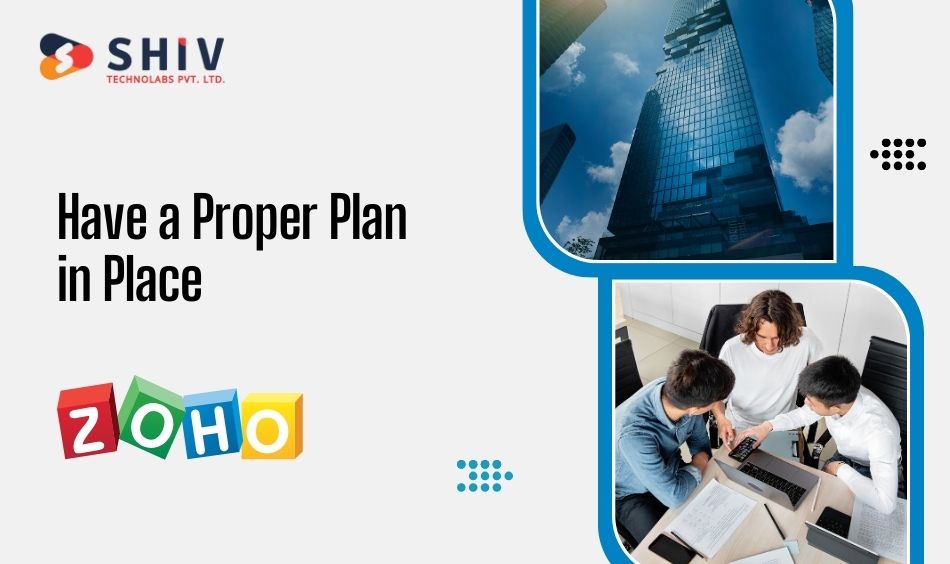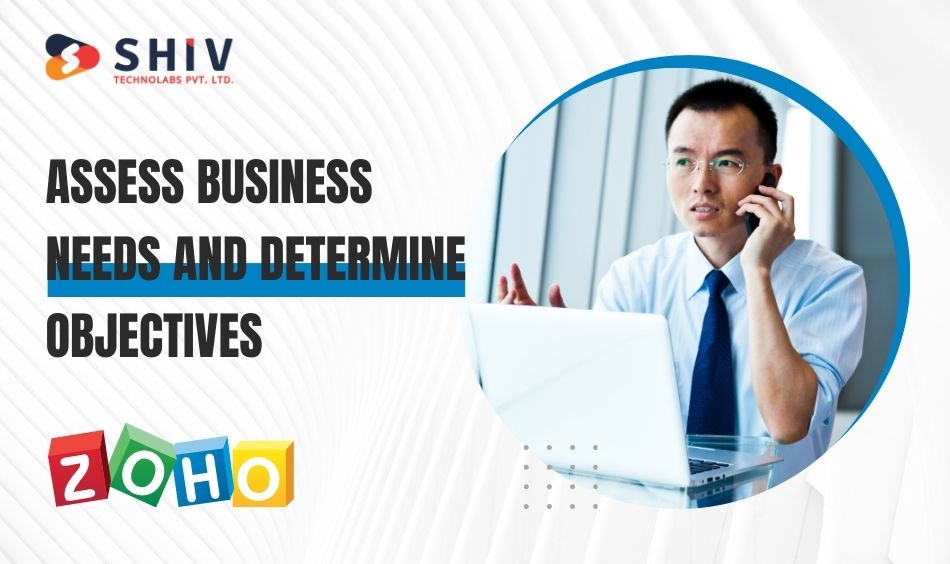Table of Contents
An efficient Customer Relationship Management system (CRM) is essential in today’s business environment which is highly competitive, and organizations are continually looking for efficient ways to manage their sales, marketing, and customer care departments. Implementing Zoho CRM properly can be the best option for every kind of business.
Every stage is critical for a successful process change: from understanding the challenges you face to creating a solid strategy, designing complex business processes, executing a perfect data migration, and ensuring a high degree of user adoption. Thus, it is time to begin discussing the best ways and means of how to implement Zoho development services effectively to maximize its functions.
Assess Business Needs and Determine Objectives
# Define Key Objectives
The initial step in deploying the Zoho CRM entails providing a clear definition of your goals. What is it that you would like the CRM to help you achieve? Below are some of the primary goals that most organizations settle for:
- Upgrade the Visibility of the Sales Pipeline: Understand and monitor the sales process of the organization by taking the various stages of the sales funnel into account.
- Make Customer Relationships Better: Improve customer relations by reaching out to them with the appropriate content at the right time.
- Run Sales Analysis: Use analytics to track sales activities, the performance of a particular team, and other activities for informed decision-making.
- Simplify Routine Tasks: Eliminate manual work with systems that perform tasks like data entry, sending email reminders, and assigning leads on a scheduled basis.
Defining specific objectives in advance is crucial because it will orient the implementation of the strategy as well as ensure the CRM is fit for purpose.
# Analyze Current Sales and Marketing Processes
Carefully assess the current sales and marketing processes in place. Where are the weaknesses and how can Zoho CRM solve these problems:
- Promotional Activities: Evaluate your present marketing approaches and all the tools in use. How can Zoho CRM be of help here?
- Sales Processes: Evaluate the lead management process from lead generation to conversion. Spot the constraints and weaknesses.
- Customer Service: Observe the team dynamics of client interaction, as well as the role of Zoho CRM in enhancing such client interactions.
# Involve all Key Stakeholders
The timely participation of the major stakeholders is important for successful Zoho CRM installation. The stakeholders should be involved at an early stage in the lifecycle of the implementation.
- Marketing Team: Learn their processes and how the CRM can help them accomplish their tasks.
- Sales Team: Know their workflow and pain points to adapt the CRM to fit their requirements.
- IT Department: Provide technical support and integration, involving IT personnel.
Involve these stakeholders as soon as possible in the processes, to address their requirements and promote teamwork.
Choose the Ideal Zoho CRM Edition
Zoho CRM provides several editions to meet all types of business needs:
- Standard Edition: Optimized for small businesses or groups that require only the basic functionalities of sales, including lead intake and management, sales generation, and sales process shortening.
- Professional Edition: Ideal for expansion-stage businesses that need additional features like automation of repetitive tasks and generating reports in custom formats.
- Enterprise Edition: Provides requisite services to multinational corporations with sophisticated requirements, offering a high degree of personalization, superior business intelligence and analytics, bespoke solutions, and extensive connectivity.
Pick the version that is appropriate to your business goals and financial constraints. If your business organization has any difficulty in choosing the most appropriate Zoho CRM edition for your operations you can consult your Zoho customization agency to get a better idea.
Have a Proper Plan in Place

The next step, which is supercritical, deals with the definition of the overall plan. This forms the basis upon which you plan the implementation of the Zoho CRM and it prepares you for victory. In this vital stage, Zoho CRM agencies do a lot of things to facilitate and guarantee the success of the process:
Comprehend What’s Bothering You: You go in-depth in understanding the rationale behind your move to adopt Zoho CRM. This query illuminates the pertinent issues and challenges you are undergoing. Following this painstaking inquiry, developers can determine the areas where the functionalities and features of Zoho CRM will be most helpful. This enhances the efficiency and productive usage of Zoho CRM in the course of the project implementation.
Comprehend the Requirements of the Task at Hand: Companies can systematically evaluate the requirements and the overall scope of the proposed project so the classic picture is obtained. They consider several relevant and obligatory elements: the number of licenses needed and their options, cost, necessary integrations, the volume of data, and even possible negotiations. In turn, these and other aspects help to formulate the most appropriate strategy for the introduction of the Zoho CRM system into the existing ones, taking into account all the connections.
The above steps taken from the reframing stage help an organization establish a well-planned and executed Zoho CRM implementation. Resulting in enhanced processes and better customer relationship management.
Zoho CRM Configuration
The process of configuring Zoho CRM is a crucial step as it adapts the system to the specific needs of your organization. It is all about adapting the CRM system the right way so that you can have a very solid backbone and a free one as well. First things first, during the Basic Build Launch stage, you will be expected to lay the basic foundation of Zoho CRM. This entails such things as establishing user accounts, creating roles, and organizing specific access to maintain security within that space. There is no denying that this basic provision and the need to limit the number of people who access sensitive information protects the members of your team from any harm.
Also, your Zoho development company can tweak the implementation and introduce additional custom fields that enable it to capture data and insights that are unique to them and their field. By doing so, you will know that you have a very handy tool to help you keep track of or rather analyze data that is relevant to your business with the help of the CRM.
In addition to custom fields, Zoho CRM has advanced capabilities for managing workflows and process automation. You can design your own rules for custom workflows, which allow you to understand the order of the actions and cut down on the performance of boring, repetitive actions, thus easing the daily activities of the team. Besides these features of the system, it also can create automation rules that help you define conditions and events that will fire off actions such as sending out an email or changing a record. As we progress towards our objectives of the instruction for implementing Zoho CRM.
# Migrate Data
One of the most essential phases of implementing a CRM is executing data migration processes:
- Data Cleaning: Examine your existing data to stem the flow of duplicity and inaccuracies. Ensure that only precise information is uploaded into Zoho CRM.
- Data Mapping: Determine how your existing data will fit into the various fields of Zoho CRM. Draft a data mapping strategy to aid the import process and avoid any data contradictions.
A test migration should also be performed using a small dataset to preempt and fix any problems that may arise during the actual importation of data.
# Testing and Validation
When it comes to the implementation of Zoho CRM the process of testing and validation becomes very essential. First of all, there is a necessity for manual checks within the processes. Your Zoho CRM company will examine all the records including contact details, deals, documents, and related files to validate the information against your previous CRM system. Another step involves the evaluation of data transfer. This allows you to evaluate the process of migration in detail as well as the issues that may come up towards the end of the migration. Functional testing is important as well. User acceptance testing (UAT) needs to be conducted and the key actors and end-users to be involved in it.
Conclusion
Zoho CRM enhances the productivity and performance of your sales and marketing teams to a great extent. This step-by-step guide will help you navigate any risks or the business objectives involved in the implementation of Zoho CRM. If you take care of every stage of the implementation process including identifying possible drawbacks and addressing them, you can get the maximum benefit from using Zoho CRM. At Shiv Technolabs, our Zoho CRM Implementation experts help you leverage Zoho CRM to its fullest potential. If you have any questions about Zoho CRM implementation, you can contact us. With us, your successful CRM implementation is just a step away!





















